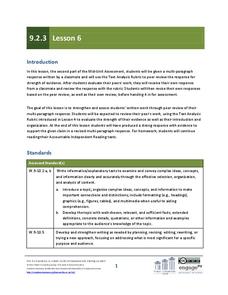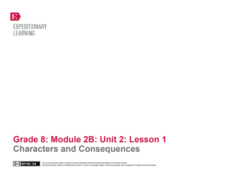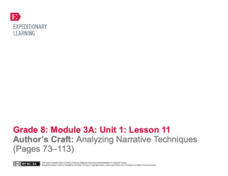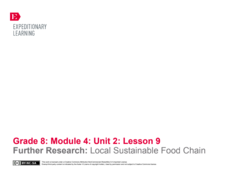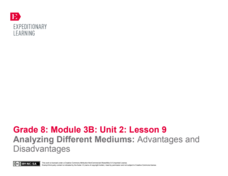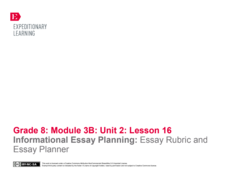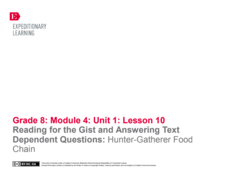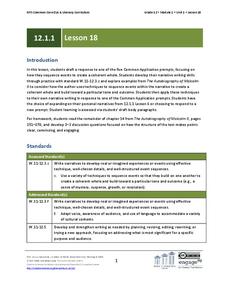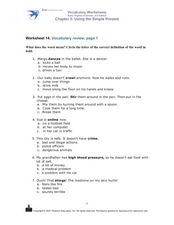EngageNY
Grade 9 ELA Module 2, Unit 3, Lesson 6
As part of a mid-unit assessment, class members exchange their draft of a multi-paragraph essay with a classmate, review their partner's writing using the provided text analysis rubric, and evaluate the strength of evidence, the...
EngageNY
Grade 9 ELA Module 4, Unit 1, Lesson 29
Writers review the provided essay rubric, edit and rewrite if necessary, polish their work, and then submit their argument essay.
EngageNY
Grade 10 ELA Module 2: Unit 1, Lesson 10
Scholars review the previous nine lessons of analysis of King's "Letter from Birmingham Jail" and use their work to create a formal essay responding to a writing prompt about the purpose of the work. This mid-unit assessment is a quick...
EngageNY
Grade 10 ELA Module 3: Unit 2, Lesson 4
Scholars take a close look at evaluating sources and the information that comes from them. Learners review their research plans, use a handout organizer to learn how to take notes, and begin annotating correctly. They practice what they...
EngageNY
Grade 10 ELA Module 3: Unit 2, Lesson 13
Is that your final answer? As part of the last lesson, scholars finalize their research portfolios. They review all of their claim tools and gain the perspective of others as they discuss their work with a group. To finish, they write...
EngageNY
Grade 11 ELA Module 2: Unit 1, Lesson 9
Change for the better. Scholars continue their study of the chapter "Of Our Spiritual Strivings" by looking at paragraph eight. They study how Du Bois continues to develop his ideas by describing the changes after the passing of the...
EngageNY
Grade 11 ELA Module 2: Unit 1, Lesson 24
You can never be too prepared. Scholars begin preparing for the end-of-the-unit assessment of Du Bois’s "Of Our Spiritual Strivings" and Washington’s "Atlanta Compromise" speech. They use peer discussion to discuss the relationship...
EngageNY
Grade 11 ELA Module 2: Unit 1, Lesson 20
Scholars analyze the fifth paragraph of Booker T. Washington's "Atlanta Compromise" speech. They learn more about his point of view toward color as he addresses the "white race." Pupils review their Idea Tracking Tools in pairs, answer...
EngageNY
Central Idea and Supporting Details: “Equal Rights for Women”
It's my right, not a privilege! Scholars review the details of the claims in the speech "Equal Rights for Women." They meet with one of their discussion appointments from a previous instructional activity to locate evidence to support...
EngageNY
Peer Critique of “Inside Out” and “Back Again” Poems
Class members closely examine the use of words in the poems "Inside Out" and "Back Again" to determine if different words would create more powerful poetry. They then conduct peer reviews of the poems they created and offer suggestions...
EngageNY
Characters and Consequences
Scholars consider how dialogue reveals aspects of a play's characters as they read Shakespeare's A Midsummer Night's Dream and complete a written conversation note-catcher. Additionally, pupils participate in an I Have/Who Has jigsaw...
EngageNY
End of Unit 2 Assessment, Part 2: Revise Essay Drafts
Time to revise! Scholars revise their argument essays based on Shakespeare's A Midsummer Night's Dream using feedback from their teacher and peers. They begin their revisions after reviewing a mini-lesson on proper writing conventions.
EngageNY
Author’s Craft: Analyzing Narrative Techniques (Pages 73–113)
Scholars discuss a reading selection in Unbroken by writing to a partner about text selection. After completing the writing, learners revisit the use of active and passive sentences by reviewing a second Active and Passive Sentences...
EngageNY
Local Sustainable Food Chain: Determining Cascading Consequences Using The Omnivore’s Dilemma
What are the consequences of the local, sustainable food chain? Research teams explore the question as they review Michael Pollan's The Omnivore's Dilemma. The teams complete Cascading Consequences charts and then choose research topics...
EngageNY
Further Research: Local Sustainable Food Chain
Researchers review how to create citations, find reliable sources, and paraphrase. Next, using guided task cards and their researcher's notebooks, they investigate the question they developed in instructional activity eight about the...
EngageNY
Analyzing Different Mediums: Advantages and Disadvantages
How do authors play to people's moods? After briefly reviewing mood using a Conditional and Subjunctive Mood handout, learners practice identifying conditional and subjunctive sentences in the Montgomery Bus Boycott speech before reading...
EngageNY
Informational Essay Planning: Analyzing and Selecting Evidence
Class members look again at the end-of-unit essay prompt for A Mighty Long Way. After reviewing the requirements of the essay, they use their Gathering Evidence note-catchers and color-code the evidence that matches the two questions in...
EngageNY
Informational Essay Planning: Essay Rubric and Essay Planner
Class members dig into the expectations for the end-of-unit assessment for A Mighty Long Way by studying the rubric. The Rubric Criteria strips help pairs of readers look more closely at specific rubric points. They share ideas with the...
EngageNY
Reading for the Gist and Answering Text Dependent Questions: Hunter-Gatherer Food Chain
Readers use sticky notes and a close reading guide to identify the gist of "My Pig" on pages 240–245 of The Omnivore's Dilemma. After reviewing their thoughts with peers, they answer text-dependent questions about the section.
EngageNY
Grade 12 ELA Module 1: Unit 1, Lesson 27
Using their notes developed throughout the unit, class members prepare for the end of the unit assessment by writing a formal essay in which they "analyze how the author of The Autobiography of Malcolm X provides a conclusion that...
EngageNY
Grade 12 ELA Module 1: Unit 1, Lesson 18
Class members take a break from discussing The Autobiography of Malcolm X to focus on their personal narrative essays. Before working on their drafts, they review what they have learned from their study of Haley's narrative about...
Scholastic
Identifying a Target Audience
How do advertisers try to speak to you? Learners review a variety of advertisements and identify how they attempt to reach a particular targeted audience, as well as consider what type of audiences they might belong to as young...
Curated OER
Vocabulary Review: Definitions
Learners read sentences with highlighted words, use context clues, and select the correct meanings of those words from three choices. Sheet contains 10 practice opportunities.
Curated OER
Vocabulary Review: Word Meanings
Provide this to your class as they learn to develop vocabulary. There are 10 questions, and the reader must read the sentence and guess the meaning of the bolded word. There are three choices for each question.
Other popular searches
- Ged Language Arts Review
- Fact Language Arts Review
- Language Arts Review Games
- Fcat Language Arts Review
- Free Language Arts Review
- Novel Study Language Arts
